The Sucking and the Blowing — A Lesson in Duct Leakage
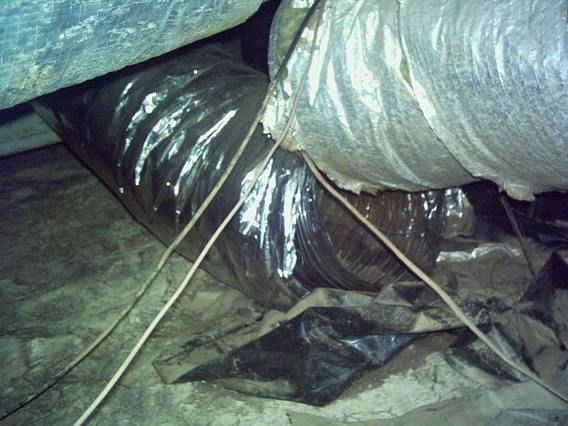
Duct leakage is a big deal. It’s one of the top three energy wasters in most homes (air leakage and cable TV set-top boxes being the other two). Researchers at Lawrence Berkeley National Lab found that duct systems leak on average about 10% of the supply air they move and 12% of the return air (download pdf). In far more homes than you might suspect, the main culprit is a disconnected duct, as shown below, but a typical duct system has a lot of other leaks, too. But another problem occurs with the duct leakage to cause even more wasted energy.
Where do the ducts leak?
In addition to how much air is leaking from the ducts, you need to know where it leaks. Leakage inside the building enclosure isn’t so bad because it’s still in the conditioned space. You still don’t want much of it, though, because it can cause comfort problems and maybe a little extra energy use. Leakage outside—in an unconditioned attic, crawl space, basement, or garage—is what you really pay for…and sometimes you pay twice. Here’s why.
Whether the ducts leak inside or outside the building enclosure is only one leakage location that matters. Your home is also affected by how much leakage occurs on the return side and the supply side of the duct system. Take a look at the diagram below.
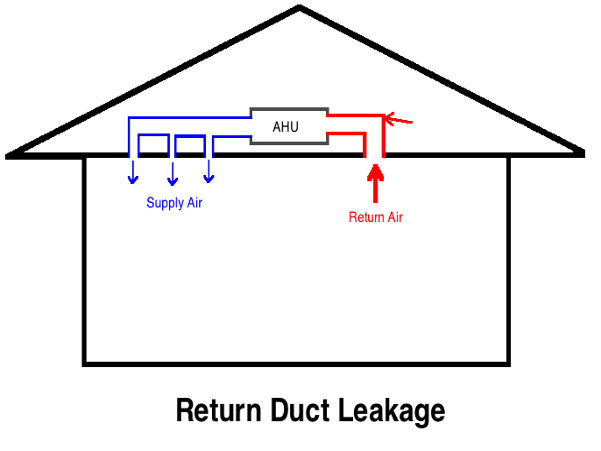
In this case, all of the leakage is on the return side of the duct system, the side that pulls air back to the furnace, air conditioner, or heat pump to be heated or cooled. Without looking below, what do you think return leakage by itself does to the pressure in the house?
Likewise, the duct leakage could be all on the supply side, the ducts that send conditioned air back into the house. The diagram below shows that scenario. How do you think the pressure in the house is affected by this type of duct leakage?

Are you unbalanced?
Well, let’s put some numbers on it and take a look. First, let’s assume we have a 2.5 ton air conditioner and further assume it’s moving 1000 cubic feet per minute (cfm) of air. On the supply side, the ducts are putting 1000 cfm of air back into the house because there’s no leakage. On the return side, let’s say we have 100 cfm of leakage. That means in this case, the return ducts are pulling in 100 cfm of air from the unconditioned attic. Since 1000 cfm total is going through the air handler, it has to pull 900 cfm from the house.
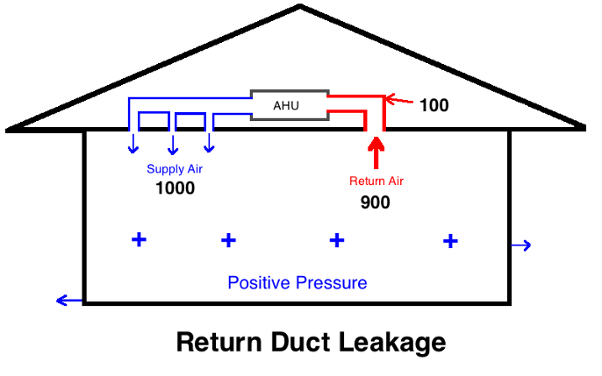
Hmmmm. Pulling 900 cfm from the house and putting 1000 cfm into the house. The pressure is higher inside the house than the pressure outdoors. We say the indoor pressure is positive. That extra air’s gotta go somewhere, so it leaks out. We get more exfiltration from the house when this system is running than when it’s off.
Another possibility here is that the positive pressure in the house reduces the air flow in the HVAC system. We still have unbalanced duct leakage and a positive pressure and more exfiltration. But instead of 1000 cfm total moving through the system, we might get only 950 cfm because the blower just can push as much air against that extra pressure in the house.
Most blowers are already fighting against the extra pressure in the duct system. The National Comfort Institute has done a lot of air flow testing, and they’ve found the typical restrictive duct system results in a total external static pressure (TESP) of 0.8″ of water column (iwc) whereas the standard blower is rated for a maximum TESP of 0.5 iwc.
Now let’s look at the supply ducts.
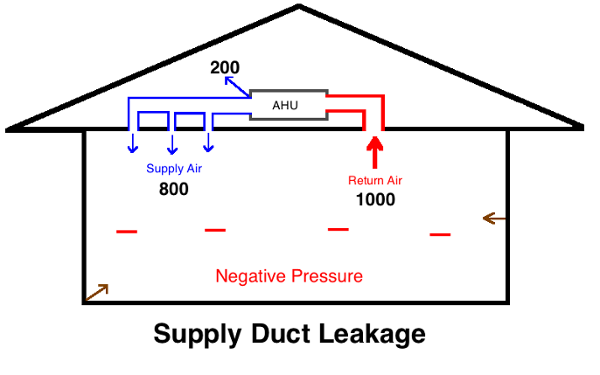
Assuming 200 cfm of supply duct leakage here, we end up with a negative pressure in the house and more infiltration. Again, we may have less air flow in the HVAC system, too.
The two scenarios I described above have either all return duct leakage or all supply duct leakage, but all that really matters is that you have unbalanced duct leakage. You’re most likely going to have leakage on each side.
A shocking mnemonic
I don’t know who first said it, but I think pretty much everyone who goes through a home energy rater class learns an easy way to remember what happens.
Return leaks blow.
Supply leaks suck.
Now you’ll never forget it. Right?
How to find out if you have unbalanced duct leakage
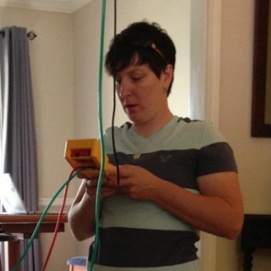 An easy way to find out if you have unbalanced duct leakage is to turn on the air handler and see what happens to the house pressure. You can do that in more than one way, of course. You could use a manometer, if you have one.
An easy way to find out if you have unbalanced duct leakage is to turn on the air handler and see what happens to the house pressure. You can do that in more than one way, of course. You could use a manometer, if you have one.
That’s what Jessica is using in the photo here. You set it up to measure the pressure in the house with reference to the outdoor pressure. If the number is positive, you have more return duct leakage than supply duct leakage. If negative, you have more supply duct leakage than return duct leakage.
Another way to determine if you have unbalanced duct leakage is to use what Joe Lstiburek calls the “look, lick, and squirt test.” With the air handler running, you can look for evidence of air movement in spider webs or tissue paper. You can also lick your fingers and hold them in a slightly cracked door to feel if air is moving through the opening. Or you can squirt a little bit of smoke near the opening.
If you’re a professional, though, you should heed Joe’s advice about this test: Never let the client see you licking your hands.
Finding balance
So what do you do if you have unbalanced duct leakage? Well, the quickest solution would be to balance it by poking some holes in the less leaky side of the duct system. That’s a terrible idea, though, and I want you to forget you ever heard it. And don’t think of a pink elephant either!
No, the real way to fix it is to seal the duct leaks. But be careful! Sealing a duct system may result in some unintended consequences that could be worse than the problem you’re fixing. If you have a restrictive duct system, you could reduce the air flow enough to freeze the evaporator coil, burn out the compressor, or crack the heat exchanger.
Duct sealing has to be done in conjunction with air flow measurements and a complete duct system retrofit or replacement.
Another teaser
I’ve been meaning to write this article for a long time. I finally got the inspiration to write it because I need it to support an article I’m going to publish soon, probably next week. I recently got asked what I thought about a project on Kickstarter, and I was aghast at what I saw. I mentioned it in my article on the Aros smart window air conditioner, and now you know it’s related to unbalanced duct leakage. Can you guess what the idea is?
Update: I did write that article. It’s about so-called smart vents. You can read it here:
Can You Save Money by Closing HVAC Vents in Unused Rooms?
Related Articles
4 Ways a Bad Duct System Can Lead to Poor Indoor Air Quality
Are You Using Vent Caps for Duct Leakage Tests Yet?
What’s That Ice Chest Doing in This Attic Duct System?
NOTE: Comments are moderated. Your comment will not appear below until approved.
This Post Has 10 Comments
Comments are closed.

I recently saw a different
I recently saw a different form of unbalance. I was visiting my daughter who has an air handler in a closet (very common for non-basement homes) and noticed that the closet door would pull shut when the air handler was running. This system only had supply ducts to the rooms and a central return to the side of the closet – which was obviously much too small. We cut an additional hole in the drywall and installed an additional, larger return grill to better balance the air flow.
David E.:
David E.: Indeed, that can put a serious dent in air flow and also cause the coil-freezing, compressor-blowing, heat exchanger-cracking problems I mentioned above. We wrote about that issue a few years ago and one way to solve it:
Helping an Asthmatic HVAC System to Breathe
.
I have a dear friend who
I have a dear friend who lives in a 7 year old building filled with 60 very expensive condos -about 60 of them.
They all have their heat pumps – one or two, depending on the size of the condo – in closets with fully louvered doors. The louvers are so close together that the air flow is so restricted that the door has to be open about 18″ or it will slam shut. It is maddening that this was done in the first place and apparently approved by the mechanical inspect and the building owners will do nothing about it.
And, there are no return air paths from the bedrooms and most of the units are oversized. And people are paying over $1,000,000 for this!!
We’ve still got a LOT of educating to do.
I assume that shutting a
I assume that shutting a bedroom door (with no air egress) leads to a positive pressured bedroom and negative pressured house. What about just closing an unused bedroom’s supply register (leaving the door open)?
John R.:
John R.: Happens all the time. See the link in my last comment. See you at Summer Camp?
Bob S.: Ah, how did you know where I was leading with all this?
Daryl: No, actually flex duct is easier to get airtight than rigid duct. I’ve seen old hardpipe systems that fall apart when you take the insulation off. Flex duct has an airtight inner liner, so if you seal the connections, trunks, plenums, and air handler (and don’t do stupid things), it’s very tight. Of course, flex isn’t often installed well, but getting proper air flow is usually a bigger problem than duct leakage.
Thanks for the info on duct
Thanks for the info on duct leakage outside the building envelope. Here in Michigan I need some heavy duty ammo to convince folks that it is important to seal all ducts, even ducts inside the building envelope. Because it is, isn’t it? ENERGY STAR Qualified Homes thinks so with its very tight total leakage requirement. I try the comfort argument, I try the consistent temperature argument, I try the balanced air flow and pressure argument, but folks don’t care cuz they are stuck on “it is all leakage inside the thermal envelope so who cares”. Help me with this cuz I am beginning to believe them after four years back in an area with most of the ducts inside the envelope. The big problem occurs when a builder does have ducts outside the BE and the contractor doesn’t know how to seal properly. Otherwise, folks don’t care about sealing ducts here in Michigan.
@Steve C: sounds like you
@Steve C: sounds like you understand most of the downsides to duct leakage to the inside. One energy related impact you missed is if duct leakage occurs in the floor system or any other relatively closed cavity, it will likely induce envelope leakage (e.g., to the outside). If you don’t test, you’re guessing.
As Allison described in the article, this is easy to diagnose (and to demonstrate) with a manometer.
@Greg, I suspect you
@Greg, I suspect you misunderstood the contractor. If the air measured at the vents was literally 50% of the airflow at the furnace, that would mean half of the supply air is leaking from your ducts! What he probably meant is that closing off that many registers caused the blower to slow down, thus reducing the amount of air moving through your system. Airflow in = airflow out.
In heating mode, reducing the airflow doesn’t materially impact a furnace’s output. The supply air temperature will rise, but as long as it doesn’t exceed the maximum spec, there’s no concern. Otherwise it would trip the high limit and shut off. Changing the airflow can also have a small impact on efficiency, plus or minus.
Cooling mode is a different story. If airflow across the evaporator coil is reduced 50% as you said, this would significantly reduce sensible efficiency and could cause the evaporator coil to freeze up.
Your duct system clearly needs to be balanced and the system airflow adjusted to ensure proper evaporator temperature in cooling mode. Depending on the particulars, it may be necessary to enlarge or add a return duct and/or modify your filter configuration. You should also consider getting your ducts checked for leakage. Unfortunately, these are common problems with residential HVAC.
I recommend hiring an HVAC technician experienced in airflow diagnostics. NATE or NCI certification is a good indicator.
Thank you David.
Thank you David.
I’m still curious to know what percentage of airflow loss is reasonable to expect in a balanced system? I read somewhere that 10% was a target. That seems optimistic given potential leaks and duct configuration.
@Greg, I’m still not clear on
@Greg, I’m still not clear on your use of the term “airflow loss” so I’ll answer it both ways.
When technicians air-balance a system, they should also adjust blower speed to get the airflow right. This may require reconfiguring the duct system (if it’s overly restrictive). In cooling mode, 400 CFM per ton across the evap coil is considered nominal, but it’s appropriate to go as much as 10% lower in very humid climates and 25% higher in arid climates. With furnaces, the acceptable airflow range is determined by the manufacturer. Within that range, there’s little impact on performance. I can’t be more specific than that.
Now, if by “airflow loss” you’re referring to supply duct leakage (air is literally lost to the attic, unconditioned basement or crawl), we need to also include return side leakage, which is “airflow gain” in your vernacular. The 2012 energy codes specify a maximum leakage rate (return + supply) of 4 CFM per 100 ft2 of conditioned floor area, at a test pressure of 25 Pascals. This is waived if ducts are fully inside conditioned space.
A better metric in my opinion is percentage of system airflow. In new construction I typically specify 5% max, but for an older home, 10% may be a more reasonable goal. Whether or not that can be achieved with retrofit duct sealing depends on how accessible the ducts are. The good news is that a lot can be accomplished by sealing leaks close to the air handler. These are more consequential because pressures are much greater near the blower than out at the grilles.
BTW, return side leakage often imposes a much larger performance hit than supply side leakage, especially if you have any return ducts in the attic. It doesn’t take much 130F air to cripple an otherwise capable AC. Return leaks in a damp crawl space can overwhelm the AC’s ability to pull moisture out of the house.
In any case, you may want to have an energy auditor or HERS rater perform a duct leakage test. Some air balancing technicians have the equipment to test duct leakage.